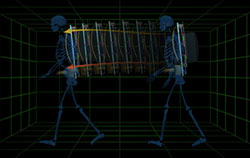 |

For further MBL News and Media Information, contact the MBL Communications Office at (508) 289-7423 or e-mail us at comm@mbl.edu
.
A New Twist on Power Walking
MBL Scientist Invents Backpack That Empowers Wearers to Generate their Own Electricity
Feature Article
Back to photos
 |
|
|
The Suspended-load Backpack, converts mechanical energy into electricity.
Image Courtesy of Dr. Lawrence Rome
|
|
WOODS HOLE, MA—In an unprecedented breakthrough in the development of portable and renewable human-driven energy sources, an MBL (Marine Biological Laboratory) biomechanics expert who studies how muscle moves skeletons in fish and frogs has invented a backpack that gives new meaning to the term power walking.
In a paper published in the September 9 issue of Science, Lawrence C. Rome, a University of Pennsylvania biology professor who spends his summers conducting research at the MBL, and three colleagues describe the mechanics of, and physics behind, the Suspended-load Backpack, a piece of gear that will one day enable field scientists, hikers, explorers, soldiers, and disaster workers to convert mechanical energy generated by walking with a heavy load on their backs into electricity.
By carrying a load weighing from 44 to 84 pounds (20 to 38 kg), Suspended-load Backpack testers were able to generate up to 7.4 Watts—more than enough electricity to simultaneously power an MP3 player, a PDA, night vision goggles (or 3 LED headlamp), a handheld GPS, a CMOS image decoder, a GSM terminal in talk mode, and Bluetooth. The electricity can be used while it is being generated, or it can be stored in a lightweight rechargeable battery for later use, greatly reducing the need to haul and use heavy replacement batteries.
“The need for electronic devices in remote areas is an increasing reality these days,” says Rome. “Throughout history, humans have solved many problems by inventing passive devices to enhance the movements made by their muscles, such as springy bamboo poles to carry loads and skis to move through snow,” he says. “The Suspended-load Backpack represents another passive device that may help solve a growing problem in the 21st century.”
The backpack, which is currently in its working prototype stage, is based on the external frame design once popular with overnight backpackers. It works by capitalizing on the up-and-down motion of the body during walking.
When walking, the body is like an inverted pendulum. After the foot is put down to take a step, the body vaults over it, causing the hip to move up and down about 1.6 to 2.7 inches (4 to 7 cm). The Suspended-load Backpack frame sits still on the wearer’s back, and the load is mounted on a load plate that is suspended from the frame by springs. The springs allow the load to slide up and down on bushings constrained to vertical rods, thus allowing the load to move with the same vertical motion as the hip, but lagging it by a fraction of a second, producing differential movement between the frame and load. The pogo-stick-like movement of the load generates mechanical energy that drives a rack-and-pinion device that powers a geared DC motor that acts as a generator mounted on the frame. The load plate can be locked to stop the device from sliding up and down and generating electricity.
To assure that the backpack wouldn’t require users to expend too much additional metabolic energy, the scientists performed a variety of tests on six male subjects, who used the backpack while walking on a treadmill.
The backpack was instrumented with force transducers and length transducers, which measured the amount of mechanical energy going into the backpack’s generator. The scientists also measured the test subjects’ oxygen consumption and carbon dioxide production rates to gauge the metabolic cost of generating electricity with the backpack.
The scientists discovered that the Suspended-load Backpack altered the gait of the test wearers, causing them to walk more efficiently. Because of this, the testers used less metabolic energy to generate electricity than anticipated. The tests also showed that the backpack wearers could generate more electricity by either walking faster or carrying a heavier load or both.
While Rome and his colleagues haven’t yet determined the biomechanical causes of the backpack’s better-than-expected efficiency, they say it confirms that the backpack is practical and that the technology can be applied to making a standard backpack that is more ergonomic.
“It seems that most everyone in the world uses a backpack to carry things, and the possibility of doing it more ergonomically and also providing electricity in remote areas may have widespread benefits, some of which we can’t even anticipate today,” says Rome.
A Pennsylvania-based company called Lightning Packs LLC has been formed to further develop and refine the Suspended-load Backpack and to develop an ergonomic backpack based on the working prototype and initial findings. Lightning Packs has applied for patent protection on both inventions.
Funding for prototyping and testing of the Suspended-load Backpack was provided by the NIH’s National Institute of Arthritis and Musculoskeletal and Skin Diseases and the Office of Naval Research.
Note: Journalists can obtain a copy of Rome’s paper by contacting Science directly at 202-326-6440, scipak@aaas.org Registered journalists may also download the paper from the Science Press Package online at http://www.eurekalert.org
The MBL is an international, independent, nonprofit institution dedicated to improving the human condition through creative research and education in the biological, biomedical and environmental sciences. Founded in 1888 as the Marine Biological Laboratory, the MBL is the oldest private marine laboratory in the Western Hemisphere. For more information, visit the MBL website.
|